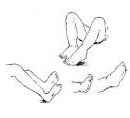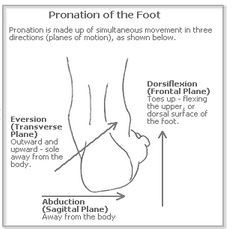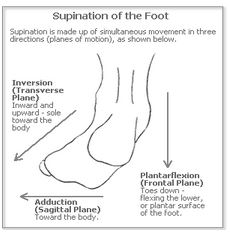PT Corner: Understanding Terminology: Ankle and Knee
 [Source: Starfish Therapies]
[Source: Starfish Therapies]
by Stacy Menz, DPT, DPT, Board Certified Pediatric Clinical Specialist
Often in physical therapy, we use certain terminology to describe the position or alignment of the legs at rest or during activity. You have probably seen these terms in your child’s evaluations or progress reports and they probably didn’t make much sense. Even if your therapist explained the meaning to you, it still might not have made much sense. Hopefully this article can help clear up the meaning of these strange words and what they indicate.
FOOT/ANKLE:
 Pronation – This is a term used to describe the sum of three different motions that together cause the heel to slant inward, the arch to collapse toward the floor, and the foot to turn outward during standing and walking. A certain amount of pronation is normal during the walking cycle. However, if there is an excessive amount present it can lead to stress on ligaments and muscles and can cause other alignment issues throughout the rest of the leg over time. Excessive pronation is most common in individuals with low muscle tone but can also occur individuals with high muscle tone.
Pronation – This is a term used to describe the sum of three different motions that together cause the heel to slant inward, the arch to collapse toward the floor, and the foot to turn outward during standing and walking. A certain amount of pronation is normal during the walking cycle. However, if there is an excessive amount present it can lead to stress on ligaments and muscles and can cause other alignment issues throughout the rest of the leg over time. Excessive pronation is most common in individuals with low muscle tone but can also occur individuals with high muscle tone.
 Supination – This term is used to describe the sum of three different motions that together cause the foot to point downward and turn inward. This foot position is common in individuals with increased muscle tone and in certain diagnoses such as Cerebral Palsy.
Supination – This term is used to describe the sum of three different motions that together cause the foot to point downward and turn inward. This foot position is common in individuals with increased muscle tone and in certain diagnoses such as Cerebral Palsy.
Pronation and supination can be present during standing or during isolated times of the walking cycle.
KNEE:
Genu Valgum (knock knees)- This term describes knees that are touching or close to touching while the lower leg is bent outwards and the ankles are separated more than normal (see picture below). This alignment is a normal part of development around 2-3 years of age and in most cases will naturally straighten out by 5-6 years of age. However, it may persist when other impairments are involved. It is often seen in combination with ankle/foot pronation described above. Very severe cases may require surgical intervention.
Read the Rest of this Article on the Starfish Therapies Blog
PediaStaff is Hiring!
All JobsPediaStaff hires pediatric and school-based professionals nationwide for contract assignments of 2 to 12 months. We also help clinics, hospitals, schools, and home health agencies to find and hire these professionals directly. We work with Speech-Language Pathologists, Occupational and Physical Therapists, School Psychologists, and others in pediatric therapy and education.
